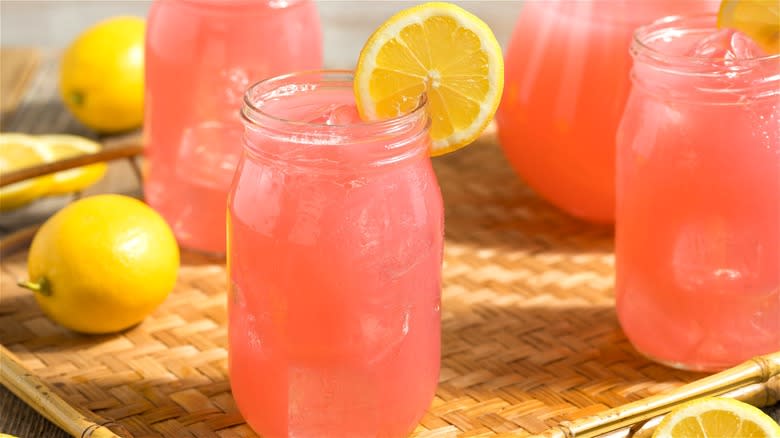Does Pink Lemonade Have A Unique Flavor?

We may receive a commission on purchases made from links.
Suppose you're looking to celebrate the last days of summer with your favorite friends, food, and drinks. In that case, you might want to craft a specially colored beverage that signifies the exuberant joy associated with warmer weather. Sure, you can add chopped cucumber and mint sprigs to an ice-cold pitcher of water, or make a few mocktail recipes everyone will love. But if you're looking to make a final toast to those hot and sunny days, nothing says summer more than a refreshing glass of ice-cold pink lemonade.
If you're wondering whether or not pink lemonade differs in taste from the classic yellow-hued drink of summer, the answer is no, the flavor really isn't different from the traditional variety. But if your sweet and simple lemonade recipe calls for only lemons, sugar, and water, how exactly can you give it that nostalgic pink color you often see in various commercial varieties?
The beginnings of pink lemonade have been traced back to a few opposing stories related to circus culture in America, with one theory blaming hard cinnamon candies for that signature pop of color. Fast-forward to present day, however, and pink lemonade is generally made by adding food dye or small amounts of concentrated juice to traditional lemonade. Any color added in the production process typically plays an inactive role in the flavor of this rosy-colored drink.
Read more: Level Up Your Tea Game With 11 Unexpected Flavors
Are There Any Real Noticeable Differences Between Traditional Lemonade And Pink Lemonade?

Though pink lemonade shouldn't really taste different from the iconic citrusy drink of summer, things become complicated when you throw psychology into the mix. For example, one 2015 study found many consumers associated red or pink-hued foods and beverages with an increased level of sweetness. Not only do our perceptions of flavor change with certain-colored foods, but many of us find the bright, rosy color of pink lemonade to be almost therapeutic.
You may wonder if the method of achieving that pink tint has any effect on the flavor, or if one method is better than the other. When it comes to store-bought varieties, there is little evidence to suggest that one coloring agent is preferred over others. In looking at a few popular products on the market, the use of red food dye and various fruit or vegetable juices varies significantly by brand. For example, Country Time pink lemonade powder contains more than one type of red dye, yet Market Pantry pink lemonade from Target is colored with only small amounts of fruit juice and grape skin extract. So while traditional lemonade is made with only lemons, water, and sugar, you have more than one way to make your own version of pink lemonade right at home, and the flavor is up to you.
How To Make Homemade Pink Lemonade

Depending on what you use to turn your next pitcher of lemonade a lovely shade of pink, your snazzy beverage may or may not hold slightly more nutritional benefits than regular lemonade. The most common ingredient recommended to change the color of classic lemonade is natural cranberry juice. According to Healthline, cranberry juice contains significant amounts of antioxidants such as vitamins C and E. While you may only be adding a small amount of cranberry juice -- typically ½ cup to 1 cup per pitcher, depending on your recipe -- you'll at least be consuming an extra microdose of vitamins.
Besides cranberry juice, feel free to use other fruits such as watermelon or raspberries. You can also opt for a more basic, shelf-stable ingredient such as grenadine, which is a simple syrup composed of sugar and pomegranate juice, or traditional food dye. Just remember a small amount goes a long way, especially if the overall goal is to simply add a vibrant hue to your deliciously tangy lemonade.
On the other hand, if you do want to experience a more fruity beverage, use more juice or make a variety with blended produce, such as refreshing strawberry lemonade. If you want to get even more adventurous, you can use watermelon, vodka, and mint to make a fruity falcon vodka lemonade. All in all, there is more than one way to transform the taste and color of pink lemonade with the help of a few extra ingredients.
Read the original article on Daily Meal.

